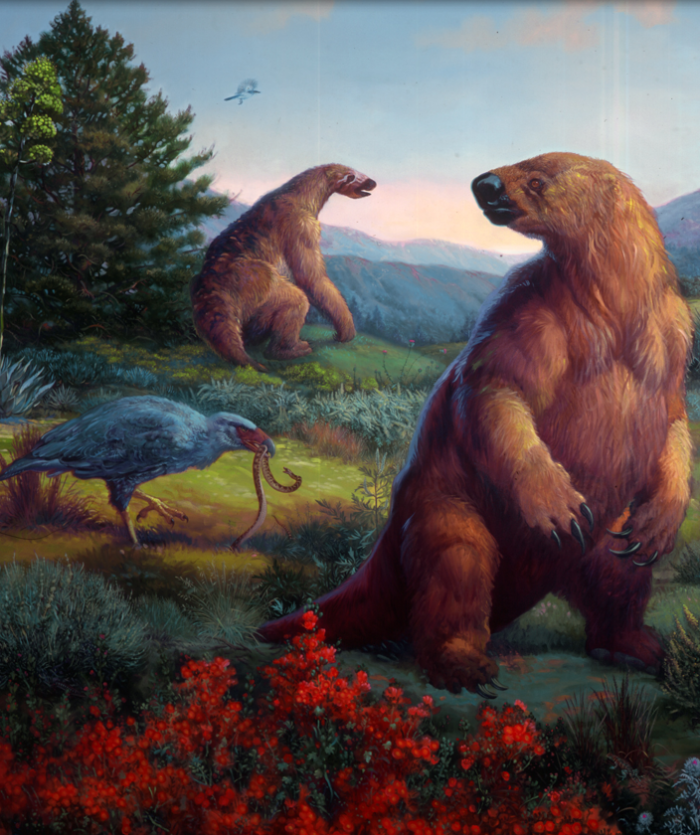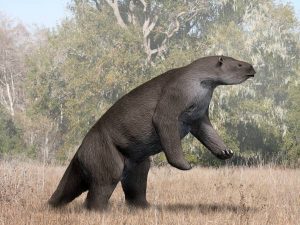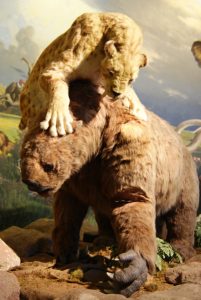
From the first prehistoric fossils discovered in the1700’s AD, giant ground sloths have lived in the Americas (North America, Central America, and South America) from 35 million years ago to many centuries past the end of the Pleistocene Era( The Ice Age).
The largest ground sloths belong to the classification known as Megatherium which comes from the Greek word “mega” meaning “great” and the Greek “thorium” meaning “beast”. Megatheriums stood 6 meters: 20 feet tall to 7 meters: 23 feet tall. These hairy giants weighed between 8,000 lbs.; 4 tons to 14,000 pounds: 7 tons. The great beasts were slow, lumbering, and cumbersome.
Another type of giant ground sloth is Megalonyx which comes from the Greek words meaning “great claw”. The name was proposed in 1797 by Thomas Jefferson(born April 13, 1743, died July 4, 1826), the American Founding Father who was the principal author of the American Declaration of Independence and later served as the third President of the United States of America from 1801 to 1809. Thomas Jefferson was given prehistoric fossils of a giant ground sloth found on the floor of a cave in the territory of the state of Virginia, later becoming West Virginia during the Wheeling Conventions of 1861 during the American Civil War. West Virginia became admitted to the Union on June 20, 1863, and was a key Civil War border state.
One type of inanimate insignia of West Virginia is its official recognition of Jefferson’s ground sloth (Megalomyx Jeffersonii) as its state fossil.
When Thomas Jefferson examined the prehistoric sloth fossils, he did not know they were from a giant ground sloth and erroneously thought they were from a tiger or a lion, until 1799. The bones were properly identified as from a giant ground sloth by Baron Cuvier (1769-1832), the French master naturalist, whose full name was Georges Leopold Cre’tien Frederic Dagobert Baron Cuvier.
Megalonyx measured about 3 meters; 9.8 feet tall and weighed up to 1,000 kilograms; 2,205 pounds. This size is considered medium among he giant ground sloths.
Megalonyx ranged over much of North America and Central America. Their remains have been found as far north as Alaska and the Yukon in Canada.
There are many other species of prehistoric giant ground sloths of the Americas. There have been ancient fossils of these beasts which show intact hairs. Colors of the fur of the sloths are black, brownish black, white, whitish black, reddish brown, red, brown, gray, or grayish brown, but may have other color combinations.

The giant ground sloths had a broad head, thick skin, and a dense shaggy coat of fur plus powerful sharp claws; all of which gave these giant mammals a good measure of protection against predators. These prehistoric sloths used their powerful forelimbs with their highly developed claws to stand in a semi-erect position while feeding on tree leaves as the sloths strip the leaves and tear off breaches. Due to their great bulky weight, the sloth giants could not climb trees. These giant furry animals also fed on hard grasses, and plants that grew on the ground, as well as shrubs, fruits, twigs, and yucca. The vast majority of giant ground sloths were vegetarians and herbivores(plant eaters), but some of these huge mammals were omnivorous(feeding on the food of both plant and animal origin.

While the percentage of these behemoths very much went down during the Ice Age because of the chilling cold climate, a great deal of these sloths survived far after the Ice Age ended. But, early stage primitive men in tribes using boulders, rocks, spears, knives; chasing the animals over cliffs; making the animals fall into disguised deep pits and then clubbed and stoned and speared to death the sloths; eating their bodies for meat made the giant sloths vanish from the Americas normally by 10,000 years ago although some of these sloths may have been hunted to extinction as lately as 8,000 years ago.
Today, there are very small sloths, only a few feet tall living in the Amazon rainforest.
But, there might still be giant ground sloths living in and around the Amazon rainforest sprawling 2, 123, 582 square miles located in South America. A continent where Megatherium originally came from and thrived for millions of years until driven to near extinction by ancient men.
Various Native American Indian tribes of the Amazon have told stories for centuries up to current times of seeing a large creature that seems very much to correspond to the giant ground sloth. Living far away from human habitation and human hunters. Although some of the stories seem fanciful; mythical; other stories seem to be sincere and tell seemingly about giant ground sloths, that are normally solitary animals, rarely in groups when they wander, but part of families, still living in South America.
Also, some people believe that at least some of the stories of Bigfoot, seen in North America, can actually be a very small number of giant ground sloths. The animals cohabitating in extreme isolation of humans in the woodlands and open fields of the United States of American and Canada.
While no skeletons of Bigfoot, the ape looking creature or the missing link; were ever found there are many, many skeletons that have been discovered in the Americas of giant ground sloths.
htttps://en.m.wikipedia.org/wiki/Ground_sloth www.lewis-clark.org/article/2742
zachofjungle.com/2015/03/26/giant-sloths-living-deep-in-the-amazon


